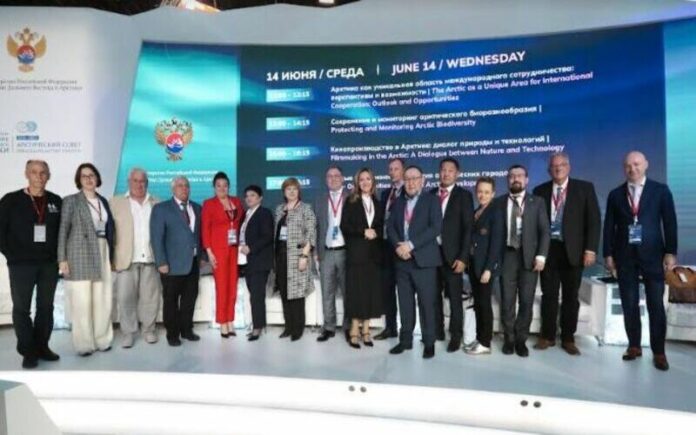Russia | India : Participants in the session ‘Protecting and Monitoring Arctic Biodiversity’, which was held at the St. Petersburg International Economic Forum, discussed the impact of climate change on the ecosystems of the Far North, the development of observation and monitoring systems, the use of modern technologies, and various aspects of public-private partnerships in matters concerning the environment. The session was held as part of the plan of events of Russia’s chairmanship of the Arctic Council in 2021–2023, which are managed by the Roscongress Foundation.
“The special natural and climatic features of the Arctic zone, its vulnerability, the uniqueness of its biodiversity, and its importance for the life of Indigenous peoples also dictate the need to further strengthen the special regulatory framework in this natural region. Today, special attention in the Russian Arctic needs to be paid to the conservation of biodiversity amidst climate change and the thawing of permafrost. It can be solved at the legal level by including special climate regulations in certain branches of legislation. The State Duma is currently considering two relevant regulatory legal acts. The further development of the integrated monitoring system is also of particular importance,” said Yelena Matveyeva, Co-ordinator of the Russian State Duma’s Subcommittee on the Protection of Lake Baikal.
The Arctic is home to 20,000 different species, which make up a significant part of the Red Book of the Russian Federation. Forty specially protected natural areas have been set up in the Russian Arctic and the bulk of them – 14 nature reserves, 10 national parks, and eight wildlife sanctuaries – are tasked with preserving biodiversity, said Olga Krever, Deputy Director of the Informational and Analytical Centre for Protected Areas Support of the Russian Ministry of Natural Resources and Environment. Krever said an integrated monitoring system needs to be set up in all specially protected natural areas, which requires a separate subsystem titled ‘Monitoring in Specially Protected Natural Areas’ as part of the Unified System of State Environmental Monitoring, amendments to the law on environmental protection, and the consideration of specially protected natural areas as unique model platforms for conducting environmental monitoring and obtaining background data.
“Soon we will all be using artificial intelligence in our activities. But I urge you not to forget that the specially protected natural areas in the Arctic zone are generally located in very hard-to-reach places, so we do not always have the physical ability to use such technologies. We are making progress in this regard: today we plan to introduce a system to obtain permits to visit specially protected natural areas, and this year we will start calculating the corresponding manmade load on each protected area,” said Irina Makanova, Director of the Department of State Policy and Regulation in the Development of Specially Protected Natural Areas of the Russian Ministry of Natural Resources and Environment.
The session was also attended by experts from specialized organizations and representatives of regional departments and companies that operate in high latitudes. Such experts included: Director of the Occupational, Industrial, and Environmental Safety Department of Zarubezhneft Yelena Kompasenko, Minister of Ecology, Nature Management, and Forestry of the Republic of Sakha (Yakutia) and Deputy General Director and State Secretary of the Arctic Initiatives Centre Rustam Romanenkov, MMC Norilsk Nickel Vice President for Ecology and Industrial Safety Stanislav Seleznev, President Emeritus of the Marine Exchange of Alaska Paul Fuhs, and Executive Director of the Marine Research Centre at Lomonosov Moscow State University Nikolay Shabalin.
The session was organized by the Russian Ministry of Natural Resources and Environment.
The session ‘Protecting and Monitoring Arctic Biodiversity’ was held at the booth of the Ministry for the Development of the Russian Far East and the Arctic in Pavilion G at the ExpoForum Convention and Exhibition Centre. The booth’s business programme included roughly 15 events. Some of them will be held as part of the plan of Russia’s chairmanship of the Arctic Council, including: the session ‘The Northern Sea Route. Results and Plans’, ‘The Russian Arctic – Focal Point. Protected Areas in the 21st Century’, and ‘Filmmaking in the Arctic: A Dialogue between Nature and Technology’.

